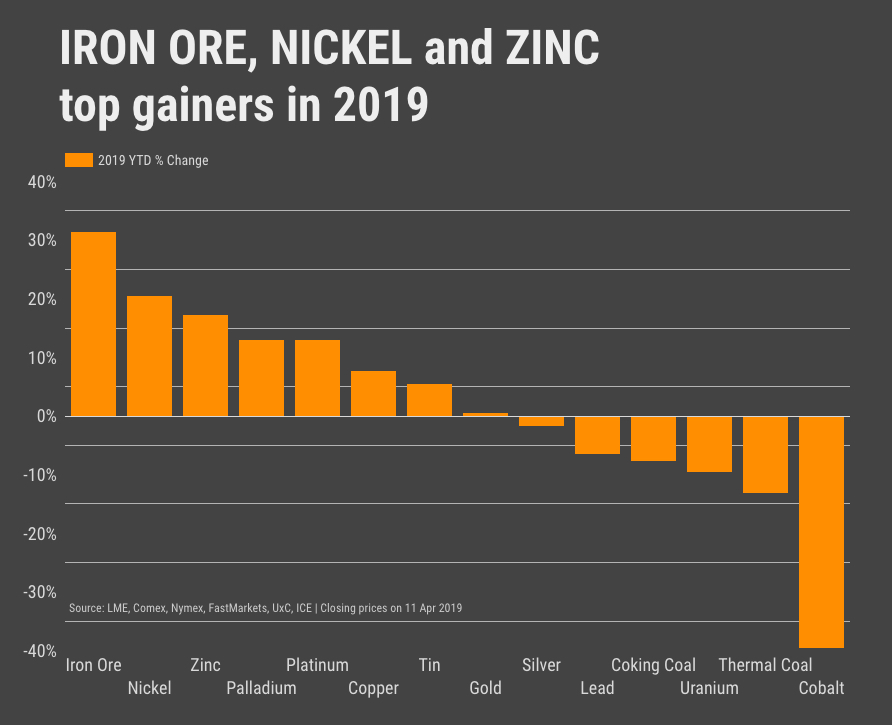
A new report by FocusEconomics on the prospects of commodities this year and next paints a mixed picture. The survey of investment banks, institutions and research houses compiled by the Barcelona-based company has good news for long-suffering investors in uranium and silver, while those who burned fingers in the rise and fall of cobalt could also look forward to some relief.

Gold showed promise early this year, but on Thursday the precious metal was back to square one for 2019, dropping through the psychologically important $1,300 an ounce level. Consensus is for gold to revisit its February high around $1,350 by the end of the year, as sluggish global growth, stalled interest rates in the US and safe haven demand prompt physically-backed gold ETF investors to jump back in and central banks continue their buying spree.
Silver’s continued underperformance – it was back below $15 again Thursday – has been a real disappointment with the precious metal failing to capitalize on shrinking mine supply, the fact that half of overall demand is from industry (and a good chunk of that from green energy). Silver is set for a double digit percentage rebound from today’s levels with the more bullish forecasters including TD Securities, BNP Paribas and Goldman Sachs, seeing a return to $17-plus during the final quarter of this year.
Platinum and palladium went in opposite directions last year with the latter stretching the gap with its sister metal to the widest in 16 years. Platinum has finally halted its decline and is trading up more than 12% in 2019 while palladium’s record-setting run on the back of supply fears from Russia and South Africa appears over for now. Palladium is likely to retreat from today’s lofty levels to trade at around $1,240 by the fourth quarter, nearly $400 below it’s March peak, according to consensus forecasts. The range of estimates for the typically opaque palladium market is broad, with bulls RBC and BMO Capital Markets seeing a return to near record levels in contrast with Commerzbank predicting another $100-plus fall from today’s levels by end-2019.
Copper jumped out of the gate this year and is holding onto a 14% gain from its January dip to around $2.50 per pound ($5,500 tonne), but analysts see little action from today’s levels. The widely used metal in industry, manufacturing, construction and transportation has been hurt by worries over China’s economic growth and the impact of the country’s trade war with the US.
Beijing’s stimulus program should encourage use and the country’s copper concentrate imports are running at record levels. Smelter expansions have increased demand and competition for copper ore in China, with spot treatment and refining charges (TC/RCs) — paid to smelters to process copper concentrate into refined metal — falling to levels last seen in 2015. Combined with sluggish new supply growth and strong demand, it paints a rosy picture for copper longer term and a handful of banks, including SocGen, BMO Capital Markets and Citigroup see the commodity rising above $7,000 a tonne in 2020.
Nickel’s rally shows no signs of running out of steam and at a shade under $13,000 a tonne, the metal has jumped 20% in value this year. Forecasters believe the steelmaking and battery material will at least stay at today’s levels although bulls including SocGen, Standard Chartered and ANZ forecast a return to $15,000 a tonne by the end of the year.
Cobalt has recovered somewhat from recent lows under $30,000 a tonne, but is still down nearly two-thirds from nine-year highs hit at the end of 2017. The battery raw material should scale $40,000 by the middle of this year and add another $10K in 2021 as thrifting of cobalt in electric vehicle cathodes is offset by the rapid increase in EV sales volumes around the world.
The surge in the price of iron ore to within shouting distance of $100 a tonne on the back of the Brumadinho disaster will not last and the panel of experts see a return to the year’s opening levels for the steelmaking raw material in the final quarter. Estimates of the loss of production from global number one producer Vale is a moving target, however, and in the short term iron ore could enjoy more price spikes. High-quality coking coal, which has held above $200 a tonne this year will also succumb to lower demand from China as the country cracks down on polluting heavy industry and construction activity slows.
The price of coal used in power generation recently rebounded from the sub-$80 a tonne mark (from more than $100 this time last year) reached a week ago, and most analysts believe current levels are sustainable, but longer term the prospects for the black stuff is not good. China’s restriction on imports and the global uptake of renewable energy dampens any prospect of a sustainable gain in steam coal prices. The move to natural gas for electricity generation in the US and elsewhere further clouds the outlook.
